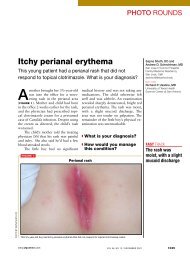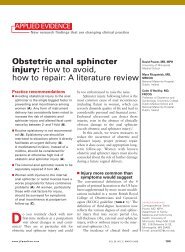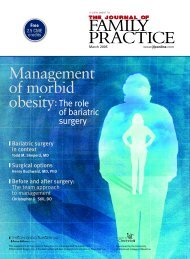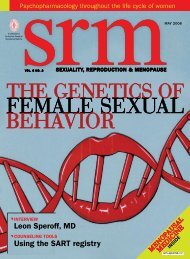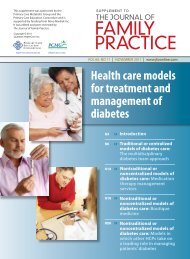Injection may be the best bet for young athletes' knee pain
Injection may be the best bet for young athletes' knee pain
Injection may be the best bet for young athletes' knee pain
You also want an ePaper? Increase the reach of your titles
YUMPU automatically turns print PDFs into web optimized ePapers that Google loves.
®<br />
PURLs<br />
Mark Sakr, DO;<br />
Anne Mounsey, MD<br />
Department of Family<br />
Medicine, University<br />
of North Carolina<br />
at Chapel Hill<br />
P U R L s E D i t O R<br />
John Hickner, MD, MSc<br />
Cleveland Clinic<br />
Young athlete<br />
sidelined? check to<br />
see how<br />
he’s coping<br />
Samantha o’connell,<br />
PhD<br />
www.jfponline.com<br />
486 The Journal of family PracTice | auGuST 2012 | Vol 61, no 8<br />
Priority updates from <strong>the</strong> research literature<br />
from <strong>the</strong> family Physicians inquiries network<br />
<strong>Injection</strong> <strong>may</strong> <strong>be</strong> <strong>the</strong> <strong>be</strong>st <strong>be</strong>t<br />
<strong>for</strong> <strong>young</strong> athletes’ <strong>knee</strong> <strong>pain</strong><br />
Closure of <strong>the</strong> tibial growth plate—<strong>the</strong> definitive remedy<br />
<strong>for</strong> Osgood-Schlatter disease—<strong>may</strong> <strong>be</strong> years away.<br />
Adolescent athletes sidelined by <strong>pain</strong> need relief now.<br />
PRACTICE CHANGER<br />
Consider giving dextrose/lidocaine injections<br />
to adolescents with Osgood-Schlatter<br />
disease (OSD) that persists despite physical<br />
<strong>the</strong>rapy. 1<br />
StREngtH Of REcOMMEnDAtiOn<br />
A: Based on one well-designed, randomized<br />
controlled trial (RCT).<br />
Topol GA, Podesta LA, Reeves KD, et al. Hyperosmolar dextrose injection<br />
<strong>for</strong> recalcitrant Osgood-Schlatter disease. Pediatrics. 2011;128:<br />
e1121-e1128.<br />
ILLUSTRATIVE CASE<br />
a 13-year-old boy comes in to your office <strong>for</strong><br />
follow-up of anterior <strong>knee</strong> <strong>pain</strong> from oSD<br />
that has not responded to 2 months of physical<br />
<strong>the</strong>rapy. he is still unable to play on his<br />
recreational soccer team. What treatment can<br />
you offer to help him return to <strong>the</strong> sport he<br />
enjoys?<br />
OSD is characterized by inflammation<br />
of <strong>the</strong> growth plate just <strong>be</strong>low <strong>the</strong><br />
<strong>knee</strong>, <strong>the</strong> result of repetitive strain<br />
on <strong>the</strong> secondary ossification center of <strong>the</strong><br />
tibial tu<strong>be</strong>rosity. 2 Closure of <strong>the</strong> tibial growth<br />
plate is <strong>the</strong> definitive remedy <strong>for</strong> OSD, but<br />
<strong>the</strong> <strong>pain</strong> that some adolescents experience<br />
until that happens can <strong>be</strong> long-lasting and<br />
considerable. Nine years after diagnosis of<br />
OSD, one study found, up to 60% of patients<br />
who had received conservative treatment reported<br />
<strong>pain</strong> on <strong>knee</strong>ling and 18% had sports<br />
limitations. 3<br />
inability to play <strong>may</strong><br />
affect self-esteem<br />
Adolescents whose recreational activities are<br />
limited due to OSD <strong>may</strong> experience a num<strong>be</strong>r<br />
of negative effects, including alienation<br />
from friends, altered peer group dynamics,<br />
and a decline in self-esteem. Surgery, which<br />
involves excision of <strong>the</strong> <strong>pain</strong>-producing ossicle<br />
with or without tu<strong>be</strong>rculoplasty, relieves<br />
<strong>the</strong> <strong>pain</strong> and allows patients to return to <strong>the</strong>ir<br />
chosen sport in 90% to 95% of cases that have<br />
not responded to conservative treatment. 4,5<br />
For a self-limiting (although prolonged) condition<br />
like OSD, most physicians and patients<br />
would prefer to avoid surgery and opt <strong>for</strong> a<br />
more conservative approach.<br />
Dextrose injections have <strong>be</strong>en shown to<br />
<strong>be</strong> safe and effective when used <strong>for</strong> <strong>the</strong> treatment<br />
of tendon and ligamentous disorders<br />
such as Achilles tendonitis and lateral epicondylitis,<br />
although <strong>the</strong> mechanism of action<br />
is not clear. 6,7 The study detailed in this PURL<br />
is <strong>the</strong> first prospective RCT of dextrose injections<br />
<strong>for</strong> <strong>the</strong> treatment of OSD.<br />
STUDY SUMMARY<br />
injections get adolescents<br />
back in <strong>the</strong> game<br />
Topol et al1 sought to compare <strong>the</strong> efficacy<br />
of injections of dextrose and lidocaine with<br />
lidocaine-only injections or supervised usual<br />
care in treating OSD in <strong>young</strong> athletes.<br />
Sixty-six Argentinian boys and girls ages 9 to<br />
17 years, all of whom had anterior <strong>knee</strong> <strong>pain</strong>
and participated in kicking or jumping sports<br />
on organized teams, were considered <strong>for</strong> <strong>the</strong><br />
study. The absence of ei<strong>the</strong>r patellofemoral<br />
crepitus or proximal patellar tendon tenderness<br />
was a prerequisite <strong>for</strong> participation, as<br />
was reproduction of <strong>the</strong> anterior <strong>knee</strong> <strong>pain</strong><br />
and localization of <strong>pain</strong> precisely to <strong>the</strong> tibial<br />
tu<strong>be</strong>rosity during a single leg squat to confirm<br />
<strong>the</strong> OSD diagnosis.<br />
After diagnosis, <strong>the</strong> patients completed<br />
≥2 months of <strong>for</strong>mal and gently progressive<br />
hamstring stretching, quads streng<strong>the</strong>ning,<br />
and gradual reintroduction into <strong>the</strong>ir<br />
respective sports. Those who experienced<br />
<strong>pain</strong> during team play that persisted <strong>for</strong><br />
≥3 months—54 patients, all but 3 of whom<br />
were male, with a total of 65 <strong>knee</strong>s requiring<br />
treatment—were included in <strong>the</strong> study. Participants<br />
were randomized to <strong>the</strong> usual care group<br />
or to one of <strong>the</strong> injection groups, which was<br />
blinded to patients, guardians, and physicians.<br />
The injection groups received a solution<br />
of lidocaine 1%, alone or with 12.5% dextrose,<br />
at <strong>the</strong> start of <strong>the</strong> study and again at 1 and<br />
2 months. Adequate injection was determined<br />
by complete <strong>pain</strong> relief during a<br />
single leg squat, which was also used to determine<br />
both proximal and distal points of<br />
tenderness. Both injection groups received<br />
0.5-mL injections with a 27-gauge needle,<br />
repeated at approximately 1-cm intervals<br />
<strong>for</strong> a total of 3 to 4 midline injections. After<br />
5 minutes, <strong>the</strong> leg squat was repeated to detect<br />
any remaining <strong>pain</strong>, and <strong>pain</strong>ful areas<br />
were injected until <strong>the</strong> patient could do a<br />
<strong>pain</strong>-free leg squat.<br />
Because <strong>pain</strong> reduction <strong>may</strong> precede<br />
full healing, those in both <strong>the</strong> lidocaine-only<br />
and <strong>the</strong> dextrose-lidocaine groups received<br />
injections on all 3 occasions even if <strong>the</strong>y<br />
were <strong>pain</strong> free. They were instructed to avoid<br />
running <strong>for</strong> a week after <strong>the</strong> initial treatment<br />
and <strong>the</strong>n to run as tolerated. Subsequent<br />
treatments required a 3-day rest from<br />
running. Participants were able to return to<br />
<strong>the</strong>ir sport after <strong>the</strong> second injection and<br />
rest period.<br />
Patients in all 3 groups received handouts<br />
explaining hamstring stretches and<br />
quadriceps streng<strong>the</strong>ning exercises. The<br />
usual care group received individual instruction<br />
from a physical <strong>the</strong>rapist. They were also<br />
JfPonline.com auGuST 2012<br />
Visit us @<br />
jfponline.com<br />
Young athlete sidelined?<br />
Check to see how he’s coping<br />
Samantha o’connell, PhD<br />
.<br />
4 ways to listen to<br />
this audiocast:<br />
1. Go to jfponline.com<br />
2. Visit www.myjfp<br />
mobile.com/0812<br />
3. Scan this QR code to listen to <strong>the</strong><br />
audiocast on your smart phone<br />
4. Text “OSD” to 25827 from<br />
your mobile phone and follow<br />
<strong>the</strong> prompt.<br />
INSTANT PoLL<br />
Do you screen patients with resistant<br />
hypertension <strong>for</strong> genetic disease?<br />
oNLINE ExCLUSIVE<br />
• clinical inQuirieS<br />
multivitamins <strong>for</strong> healthy children: What are <strong>the</strong><br />
true <strong>be</strong>nefits?<br />
PHoTo RoUNDS fRIDAY<br />
Test your diagnostic skills.<br />
PHYSICIAN’S bRIEfING NEwS<br />
Today’s headlines in family practice<br />
GET UPDATES fRoM US oN<br />
fACEbook AND TwITTER<br />
www.facebook.com/JfamPract http://twitter.com/JfamPract<br />
www.jfponline.com<br />
487
®<br />
PURLs<br />
given a video and returned at least once, both<br />
to ensure that <strong>the</strong>y were per<strong>for</strong>ming <strong>the</strong> exercises<br />
correctly and to encourage compliance.<br />
z <strong>the</strong> primary outcome involved <strong>the</strong><br />
Nirschl Pain Phase Scale (NPPS), a 7-point<br />
measure of sports-related symptoms and level<br />
of participation. Scores of 4 to 7 represent<br />
sports limitation resulting from <strong>pain</strong>. Scores<br />



